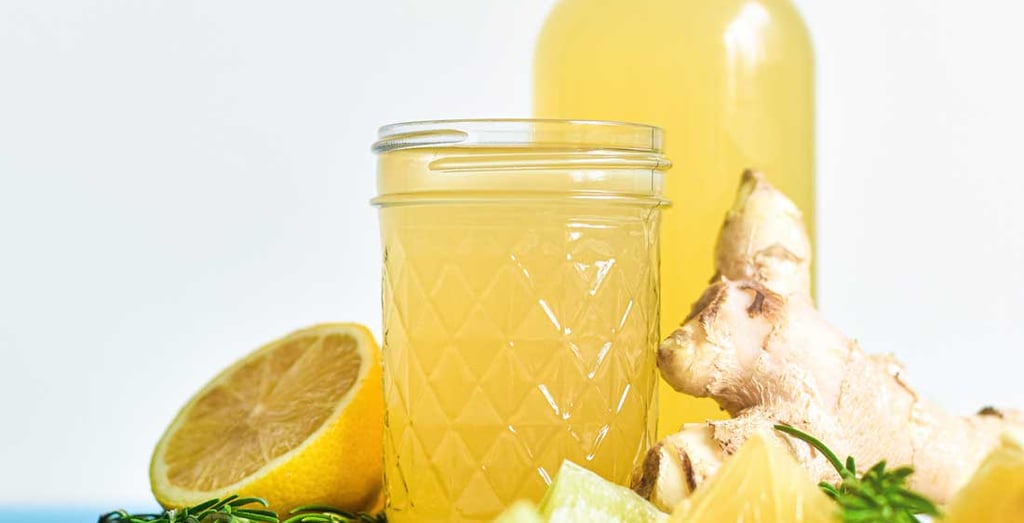Gut-Healthy Soda: Lemon & Maple
Discover the benefits of homemade fermented soda with lemon and maple syrup. A simple, healthy, and delicious recipe for a happy gut!
WELLNESSHEALTHBLOG-LIST
2/3/20255 min read


Looking for a fizzy, delicious drink that's also good for you? Forget industrial sodas loaded with sugar and additives! Today, we're diving into the fascinating world of homemade fermented soda, a natural and beneficial alternative. Get ready to discover a simple and delicious recipe, based on lemon juice, maple syrup, and a touch of fermented magic. This drink, in addition to being refreshing, is a real elixir for your gut microbiota. Ready to make your well-being sparkle?
Summary
What is Fermented Soda and Why is it Good for You?
Key Ingredients: Lemon, Maple Syrup, and Ferment
Easy Recipe: Make Your Own Fermented Soda in a Few Steps
The Benefits of Fermentation for Gut Health
Tips and Tricks for Successful Fermented Soda
In a Nutshell
Fermented soda is a naturally fizzy drink rich in probiotics.
Our recipe uses lemon juice, maple syrup, and a ferment (kefir, ginger bug, or sourdough starter).
Fermentation transforms sugars into beneficial organic acids for digestion.
This soda is a healthy alternative to industrial sugary drinks.
Easy to prepare, it can be customized to your taste.
1. What is Fermented Soda and Why is it Good for You?
Fermented soda is a beverage obtained by fermenting sugars with the help of microorganisms, such as bacteria or yeast. This natural process creates bubbles, but most importantly, it enriches the drink with probiotics, living microorganisms beneficial to our gut health. Unlike industrial sodas that often contain refined sugars and artificial additives, fermented soda offers a natural and healthy alternative. It contributes to the balance of intestinal flora, promotes better digestion, and can even strengthen the immune system.
A study published in the journal Nutrients (2020) highlights the crucial role of the gut microbiota in overall health and emphasizes the importance of a diet rich in probiotics and prebiotics to maintain its balance. (Source: Nutrients, 2020, 12(11), 3496. doi:10.3390/nu12113496)
2. Key Ingredients: Lemon, Maple Syrup, and Ferment
Our recipe is based on three main ingredients:
Lemon Juice: Rich in vitamin C and antioxidants, lemon brings a refreshing touch of acidity and stimulates the immune system. It also contains citrates that help alkalize the body. It is recommended to use the juice of 5 organic lemons for one liter of beverage.
Maple Syrup: A source of natural sugar, maple syrup feeds the ferments and provides a sweet flavor. It contains minerals like manganese and zinc, as well as polyphenols with antioxidant properties. Choose pure maple syrup, grade A or B. It is recommended to use dark maple syrup, which is richer in minerals.
Ferment: This is the magic ingredient that transforms the mixture into a fizzy soda. You can use fruit kefir grains, a ginger bug (ginger-based ferment), or even a bit of sourdough starter. Each ferment will bring a unique signature to your drink. These cultures of beneficial bacteria and yeast, when added to a sugar and water mixture, metabolize the sugar to produce lactic acid, carbon dioxide (which makes the drink fizzy), and other beneficial compounds, including B vitamins and enzymes.
3. Easy Recipe: Make Your Own Fermented Soda in a Few Steps
Ingredients:
Juice of 5 fresh lemons (preferably organic)
100 ml pure maple syrup
1 liter of filtered or spring water
Ferment (1 tablespoon of kefir grains, 1/4 cup of ginger bug, or 1 tablespoon of sourdough starter)
Optional: fresh fruit, spices, or aromatic herbs for flavoring
Preparation:
In a large glass jar, mix the lemon juice, maple syrup, and water.
Add the chosen ferment.
Stir gently with a wooden spoon (avoid metal).
Cover the jar with a clean cloth and a rubber band.
Let it ferment at room temperature (20-25°C / 68-77°F) for 2 to 7 days, depending on the temperature and the activity of the ferment. The fermentation time will vary depending on the ambient temperature and the activity of the ferment. A longer fermentation will result in a less sweet and more tangy drink.
Taste regularly to check the fermentation level. The drink is ready when it is slightly bubbly and tangy.
Filter the beverage through a cheesecloth or coffee filter to remove kefir grains or ferment residues.
Bottle (use pressure-resistant bottles, such as swing-top bottles).
CAUTION: Fermentation produces carbon dioxide gas. Do not overfill the bottles (leave a few centimeters/an inch of headspace) and open them carefully after refrigeration. It is advisable to "burp" the bottles daily by briefly opening them to release excess pressure, especially during the first few days of bottle fermentation.
Let it rest in the refrigerator for a few hours before enjoying.
4. The Benefits of Fermentation for Gut Health
Fermentation is an ancestral process of food preservation, but it is also a real source of benefits for our health. By consuming fermented foods, we enrich our gut microbiota with "good" bacteria.
A balanced gut microbiota contributes to:
Improved Digestion: Probiotics facilitate the breakdown of food and the absorption of nutrients.
Stronger Immune System: A healthy gut is the key to strong immunity.
Reduced Inflammation: Certain bacteria produce short-chain fatty acids, such as butyrate, which have anti-inflammatory properties.
Improved Mood: The gut is often called the "second brain." A balanced microbiota can positively influence our mood and mental well-being.
"The gut microbiota plays a crucial role in human health, influencing not only digestion but also immunity and even mental health," explains Dr. Emeran Mayer, author of the book The Mind-Gut Connection.
5. Tips and Tricks for Successful Fermented Soda
Hygiene: Use clean utensils and containers to avoid contamination.
Temperature: Fermentation is faster in warm weather and slower in cold weather. Adjust the fermentation time accordingly.
Taste: Feel free to adjust the amount of maple syrup according to your preferences.
Variations: Add fresh fruits (raspberries, strawberries, peaches), spices (ginger, cinnamon), or aromatic herbs (mint, basil) during fermentation to create unique flavors.
Storage: Store your fermented soda in the refrigerator to slow down fermentation and prevent bottles from exploding.
Safety: If you are a beginner, start with short fermentation times to familiarize yourself with the process. Important Reminder: Always use pressure-resistant bottles and handle them with care, especially after bottling.
FAQ
Q1: Can I use another sweetener besides maple syrup? R1: Yes, you can use honey, cane sugar, or coconut sugar. However, each sweetener will bring a different flavor and may influence the fermentation time. Maple syrup is preferred for its nutritional richness and unique taste.
Q2: My soda is not fizzy, what should I do? R2: Make sure your ferment is active. If it's not, try a new ferment. You can also add a little more sugar or extend the fermentation time. A room temperature that is too low can also slow down fermentation.
Q3: How long can I store my fermented soda? R3: In the refrigerator, your soda will keep for about a week.
Q4: Can pregnant or breastfeeding women consume fermented soda? R4: In general, yes, but it is recommended to consult a healthcare professional beforehand, especially if you have specific concerns.
Q5: Are there any contraindications to consuming fermented soda? R5: People with certain medical conditions, such as irritable bowel syndrome (IBS) or small intestinal bacterial overgrowth (SIBO), should consult a healthcare professional before introducing fermented beverages into their diet.
Conclusion
Fermented soda with lemon and maple syrup is much more than just a refreshing drink. It is a real magic potion for your gut health, a concentrate of benefits and flavors! Easy to prepare, this natural and fizzy drink is an excellent alternative to industrial sodas. So, get started, experiment, and discover the pleasure of making your well-being sparkle!
